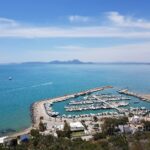Tunisia, a North African gem, offers a diverse range of experiences—from Mediterranean beaches and ancient ruins to Sahara Desert adventures and vibrant cities. Choosing the best time to visit depends on your travel preferences, whether you seek sunny beach days, cultural exploration, or outdoor adventures.
This guide breaks down Tunisia’s climate, peak tourist seasons, and the ideal months for different activities, ensuring you plan the perfect trip.
1. Tunisia’s Climate: Understanding the Seasons
Tunisia has a Mediterranean climate along the coast and a desert climate inland. The country experiences four distinct seasons:
- Spring (March–May): Mild temperatures, blooming landscapes, and fewer crowds.
- Summer (June–August): Hot and dry, ideal for beachgoers but intense in the desert.
- Autumn (September–November): Warm days, cooler nights, and great for cultural trips.
- Winter (December–February): Cool and rainy on the coast, cold in the desert.
Let’s explore the best times to visit based on different travel interests.
2. Best Time for Beach Holidays (June–September)
If you’re dreaming of Tunisia’s stunning Mediterranean coastline, summer (June to September) is the best time to visit.
Why Visit in Summer?
- Perfect beach weather (25–35°C / 77–95°F).
- Crystal-clear waters in Djerba, Hammamet, and Sousse.
- Vibrant nightlife in coastal resorts.
Top Summer Destinations:
- Djerba: Known for its white sandy beaches and relaxed vibe.
- Hammamet: Famous for luxury resorts and water sports.
- Sousse & Monastir: Great for family-friendly beaches and historic sites.
Tip: July and August are peak months, so book accommodations early.
3. Best Time for Cultural & Historical Exploration (April–May & September–October)
For travelers interested in Tunisia’s rich history—from Roman ruins to Islamic architecture—spring (April–May) and autumn (September–October) offer the best conditions.
Why Visit in Spring or Autumn?
- Pleasant temperatures (18–28°C / 64–82°F).
- Fewer crowds at UNESCO sites like Carthage and Dougga.
- Ideal for exploring medinas in Tunis, Sfax, and Kairouan.
Must-Visit Cultural Sites:
- Carthage: Ancient Phoenician and Roman ruins.
- El Jem: Home to one of the best-preserved Roman amphitheaters.
- Kairouan: A sacred Islamic city with stunning mosques.
Tip: Avoid midday heat when touring archaeological sites.
4. Best Time for Sahara Desert Adventures (October–April)
The Sahara Desert is one of Tunisia’s most breathtaking attractions, but visiting in winter or early spring (October–April) ensures comfortable temperatures.
Why Visit in Cooler Months?
- Daytime temps (20–25°C / 68–77°F), nights chilly (5–10°C / 41–50°F).
- Great for camel treks, stargazing, and desert camping.
- Avoid extreme summer heat (over 40°C / 104°F).
Top Desert Experiences:
- Douz: The “Gateway to the Sahara” for dunes and festivals.
- Tozeur & Chott el Jerid: Stunning salt flats and Star Wars filming locations.
- Matmata: Unique troglodyte (underground) homes.
Tip: Pack warm layers for cold desert nights.
5. Best Time for Budget Travel & Fewer Crowds (November–March)
If you prefer lower prices and fewer tourists, consider visiting Tunisia in winter (November–March).
Why Visit in Winter?
- Cheaper flights and hotels (except during Christmas/New Year).
- Mild coastal weather (12–18°C / 54–64°F).
- Great for city exploration (Tunis, Sidi Bou Said).
Winter Highlights:
- Tunis: The capital’s medina and Bardo Museum.
- Sidi Bou Said: A picturesque blue-and-white village.
- Spa retreats in Hammamet.
Note: Some beach resorts close in winter.
6. Worst Time to Visit Tunisia (July–August in the Desert, Peak Summer Crowds)
While Tunisia is a year-round destination, some periods are less ideal:
- July & August: Extreme heat (up to 45°C / 113°F in the Sahara).
- Peak tourist crowds in coastal areas.
- Ramadan (dates vary): Some restaurants and attractions may have limited hours.
7. Month-by-Month Breakdown of Tunisia’s Weather & Events
| Month | Weather | Best For | Events & Festivals |
|---|---|---|---|
| January | Cool, rainy | Cultural trips, city tours | International Sahara Festival (Douz) |
| February | Mild | Desert adventures, budget travel | Almond Blossom Festival (Tataouine) |
| March | Warming up | Hiking, history | Spring festivals begin |
| April | Pleasant | Beaches, ruins | Carthage International Festival (starts) |
| May | Warm | Outdoor activities, island hopping | Jazz à Carthage |
| June | Hot | Beach holidays | Mediterranean Film Festival |
| July | Very hot | Coastal resorts | Hammamet International Festival |
| August | Scorching | Island escapes (Djerba) | Sousse International Festival |
| September | Warm | Cultural tours, desert trips | Dates Festival (Tozeur) |
| October | Mild | Sahara exploration | Carthage International Festival (ends) |
| November | Cool | Budget travel, history | Olive Festival (Sfax) |
| December | Chilly | City breaks, Sahara trips | Christmas in Tunis (festive markets) |
8. Final Tips for Choosing the Best Time to Visit Tunisia
- For beaches: June–September.
- For history & culture: April–May or September–October.
- For the Sahara: October–April.
- For budget travel: November–March (avoid holidays).
Bonus Travel Tips:
✔ Book desert tours in advance during peak seasons.
✔ Respect local customs (modest dress in religious sites).
✔ Try seasonal foods (fresh seafood in summer, dates in autumn).
Conclusion: When Will You Visit Tunisia?
Tunisia’s diverse landscapes and rich heritage make it a fantastic destination year-round. Whether you’re chasing sun on Mediterranean shores, exploring ancient ruins, or trekking through golden dunes, timing your trip right ensures the best experience.
Ready to plan your Tunisian adventure? Check flight deals, pack accordingly, and get ready for an unforgettable journey!



